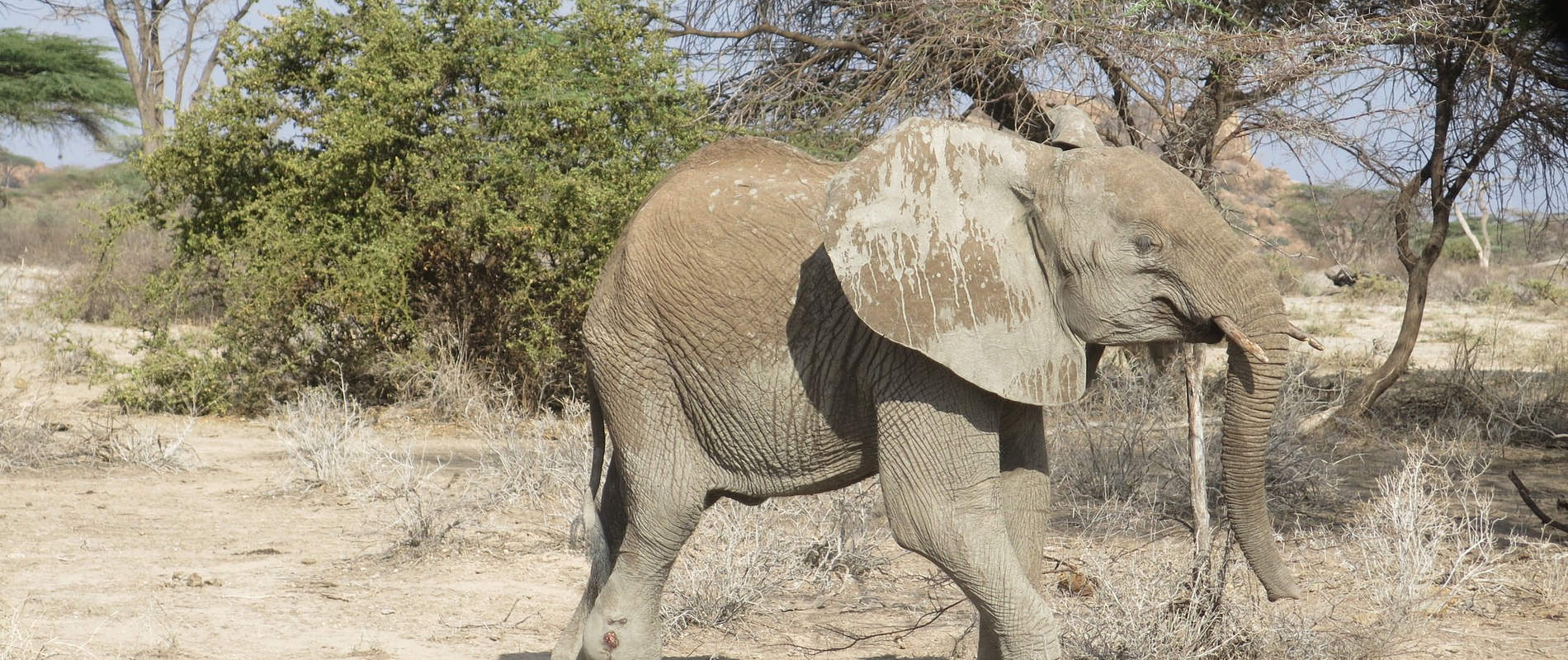Introduction This report describes activities of the DSWT/KWS Meru Veterinary Unit operating in northern Kenya in September 2017
Introduction
This report describes activities of the DSWT/KWS Meru Veterinary Unit operating in northern Kenya in September 2017. During the month dry weather conditions continued effected wildlife in northern Kenya due to scarcity of pasture and water.
On 5th September we carried out a health assessment of mountain bongo at Mt. Kenya game ranch and later drove to Nyahururu to attend to an elephant which was reported to have shown severe lameness. However, we were unable to track the elephant due to dense forest and rough terrain. On 16th September we fitted a satellite collar on a female elephant in Meru Park which will aid in monitoring, and later drove to Mpala ranch where we removed a snare on a Grevy zebra. On the 17thwe attended to an elephant in Songa, Marsabit which showed severe lameness and on 22/09/17 we treated an elephant in Shaba National Reserve for lameness.
1. BONGO HEALTH ASSESSMENT
Date: 05/09/17
Species: Mountain Bongo
History
The ranch management reported that a sick bongo had died from suspected tick-borne disease. The bongo had shown a febrile disease, loss of body condition and inappetence. Post mortem showed pulmonary edema and froth in the trachea which is consistent with theileriosis. Samples had been sent to the laboratory for confirmation of diagnosis. On 05/09/17 we visited the ranch to conduct a herd health assessment. The veterinarian also advised on tick control practices to prevent diseases.


2. DE-SNARING A GREVYS ZEBRA
Date: 16/09/17
Species: Grevy Zebra
Sex: Male
Age: Sub – adult (less than 1 year)
History
The security team at Mpala Conservancy reported a grevy zebra which had suffered severe lameness on its hind leg caused by a tight wire snare. The Meru veterinary unit immobilized this endangered zebra species to remove the snare and treat wounds caused by snare.

Chemical immobilization and physical examination
Immobilization was achieved using a combination of Etorphine hydrochloride 2mg and Azaperone tartate 40 mg delivered using a 1.5ccdan-inject dart. Examination showed traumatic wounds caused by a wire snare dorsal to the fetlock joint of the right hind leg. The wire had cut through the soft tissue causing chronic inflammation and sepsis.

Treatment and prognosis
The snare was cut using a wire cutter and carefully removed. Septic wounds were debrided using hydrogen peroxide, washed and topical povidone iodine applied.Antibiotics and anti-inflammatory drugs were also given. For reversal of sedation, Naltrexone hydrochloride was injected intravenously and the zebra ran off 45 seconds later.



Because of injury to tendons and suspected joint infection, prognosis for this case was considered guarded.


3. LION COLLARING
Date: 16/09/17
Species: Lion
Sex: Female
History
On 16/09/17 a satellite collar was fitted on a lion in Meru National Park. This activity was carried out as part of the KWS lion monitoring program in the park. This collar will provide baseline information on home ranges, daily movement patterns of this lion and its pride and interactions with other groups.


To fit the collars the lion was anaesthetized using a combination of Ketamine hydrochloride and Medetomidine hydrochloride delivered in a 3ccdan-inject dart. Induction time was 8 minutes. Vital physiological parameters were monitored during the procedure including body temperature and respiration rate to ensure they were within normal range.

Morphometric measurements were also measured and recorded. Ninety minutes after the initial dart 0.5% atipamezole was injected by intramuscular route to reverse sedative effect of medetomidine while ketamine was allowed time to wear off naturally.



4. LAMENESS IN AN ELEPHANT IN SONGA
Date: 17/09/17
Species: Elephant
Sex: Male
Location: Songa, Marsabit
History
KWS senior warden in charge of Marsabit National Park reported that an injured elephant which showed severe lameness on its right forelimb. This lone sub adult male elephant had moved out of the park into community land.
Chemical immobilization and physical examination
This elephant was tracked on foot to a wooded bush land on the eastern edge of Marsabit national park. Darting was done on foot using Etorphine hydrochloride delivered in a Daninject dart. Down time was seven (7) minutes.
Examination showed a swollen right forelimb at the elbow joint and manipulation of the leg showed joint instability.

Treatment and prognosis
Palliative treatment was given. Anti-inflammatory drugs and antibiotics were injected.

To reverse effects of opioid anesthesia, Naltrexone hydrochloride was injected intravenously through the ear vein. Two minutes later the elephant was in standing position and limped away into the forest.


5. LAMENESS IN AN ELEPHANT IN SHABA NATIONAL RESERVE
Date: 22/09/17
Species: Elephant
Sex: Male
Age: 7 years
Location: Shaba National Reserve
History
Field researchers from Save the Elephants reported that a young male elephant showed lameness and a swollen right hind leg. They requested for an assessment to determine the cause of lameness and treatment.
Chemical immobilization and physical examination
We found this lone elephant near the banks of Ewaso Nyiro River; it was calm, alert and browsing on acacia trees. It was in good body condition. The right hind leg was swollen at the hock joint and wounds were observed on the lateral aspect of the swelling. It avoided bearing weight on the affected leg.


At 1609 hr the elephant was darted using Etorphine hydrochloride 3mg and went down on lateral recumbency at 1616hr.The swollen area around the hock was firm in consistency with superficial wounds on the lateral aspect on probing with forceps and which produced no discharge on aspiration.



Diagnosis was a fracture of the tarsal bones which had healed with callous tissue formation and bone malunion.
Treatment and prognosis
The superficial wounds were debrided, cleaned and disinfected using povidone iodine. Antibiotic and anti-inflammatory drugs were injected by intramuscular route.Anesthesia at 1634hr by intravenous injection of Naltrexone hydrochloride and the elephant was in standing position at 1637hr. Although the leg will remain deformed, the injuries have healed and the elephant does not seem to be in pain.





































